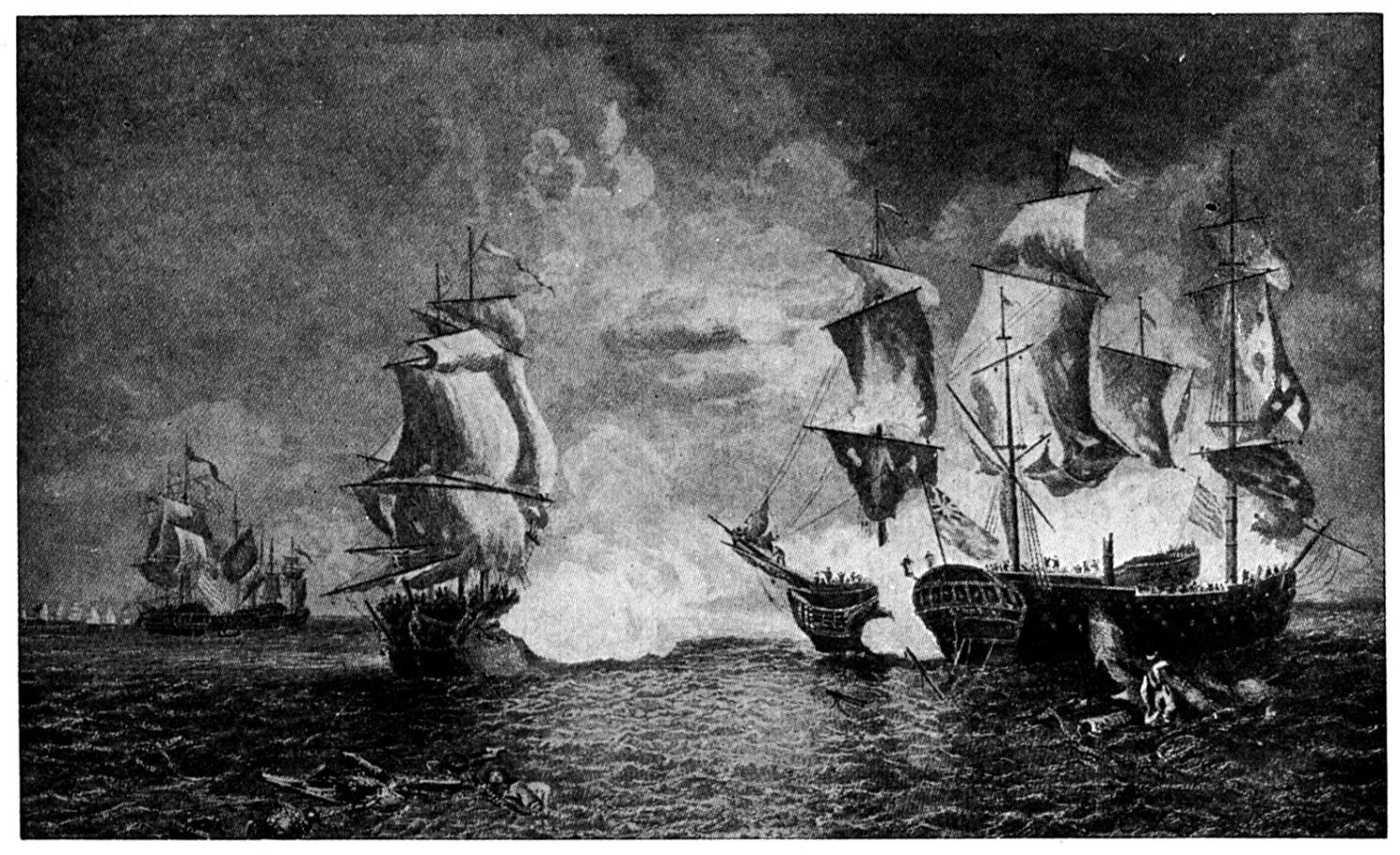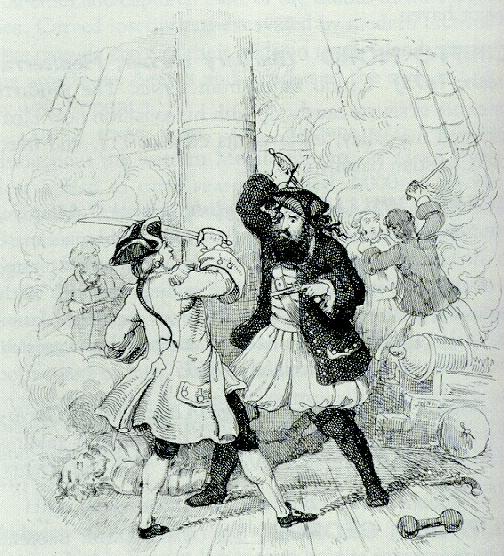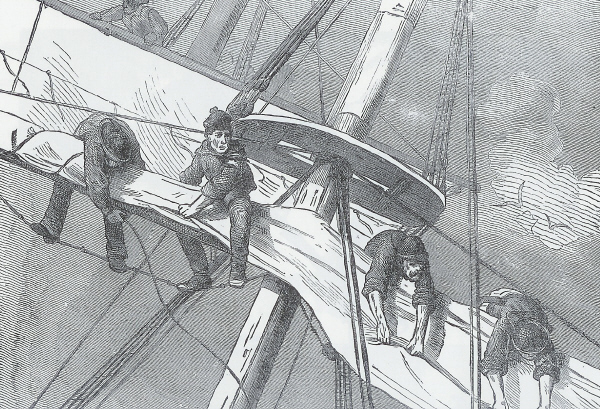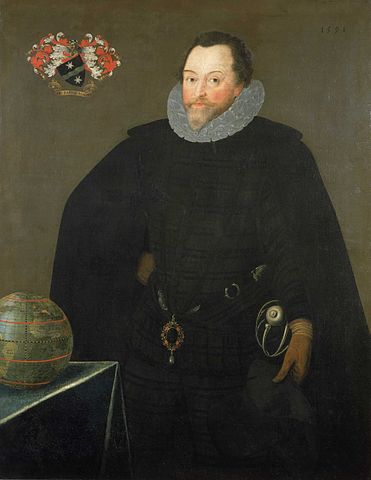By Cindy Vallar

 http://www.cindyvallar.com/Seabattle.jpg" alt="" class="bbc_img" />
http://www.cindyvallar.com/Seabattle.jpg" alt="" class="bbc_img" />
In 1720 Bartholomew Roberts and the pirates who sailed with him found themselves in a heated battle with pirate hunters. His only option was to “cut and run,” so the pirates dumped their guns and cargo overboard. They eventually escaped, but not without severe damage to the
This is but one account of how sailors fared without a doctor to tend them. If the ship possessed a
Surgeons who plied their trade at sea, rather than on land, were not new. They sailed with Roman warships, and during medieval times, they accompanied nobility and prelates on their voyages. When the Spanish Armada sailed in 1588, the eighty-five surgeons and their assistants were unable to stop the

 http://www.cindyvallar.com/Bbmay.jpg" alt="" class="bbc_img" />
http://www.cindyvallar.com/Bbmay.jpg" alt="" class="bbc_img" />
John Woodall’s
Unlike today, medicines of the past had to be put together similar to how a cook bakes a cake. The recipe for a medication consisted of a curative agent, water or oil, flavoring, and the compound used to comprise how the medication was given, for example as a pill or an ointment. The base for the latter might have been glycerin or lard. Wax sometimes held a pill together. Ingredients in ointments and liniments might include mercury, turpentine,
Perhaps Blackbeard required the medicines and instruments to treat syphilis, a common plague among sailors and pirates who frequented brothels when on shore. Of course, his crew might also have suffered from any number of other problems, for danger lurked almost everywhere aboard a wooden ship. Aside from the rats, weevils, lice, and cockroaches, livestock was kept aboard and sometimes had free reign of the deck, making for unsanitary conditions. The pirates’ clothing was often wet or damp. Depending on where they sailed, nature might also inflict hardships: sunburn, heat exhaustion, sun stroke, hypothermia, exposure, or frostbite. Their work was equally hazardous and sores, cuts, and bruises were the norm. Scurrying up or down the rigging and the frequent movement of both the ship and the mast sometimes caused sailors to lose their footing and fall. Landing in the water often meant the man drowned, for knowing how to swim wasn’t a requirement for being either a sailor or a pirate. If he was lucky enough to be retrieved from the water, sailors held the victim by his heels and shook him to remove any water in his chest.

 http://www.cindyvallar.com/Tops-D.jpg" alt="" class="bbc_img" />
http://www.cindyvallar.com/Tops-D.jpg" alt="" class="bbc_img" />
Landing on the deck might fracture a person’s skull or kill him. In 1833 Billy Bridle
Pirates, who visited lands not explored before, also encountered additional dangers.
The plants could be equally dangerous. He encountered a dwarf apple tree near the shore. Although similar to apples back home, the fruit was poisonous.
Depending on a pirate’s ailment, the surgeon might prescribe one of nine different types of medicines. Aquae – such as cinnamon water, licorice juice, and fortified peppermint water – cured hiccups and “stoppeth vomiting, cureth choler, griping paine of the belly…” according to John Woodall. (Druett, 7) Spirits, salts, and tinctures – like salts of wormwood, vinegar, and  It was also used to make the varnish used on violins. Around 1640 Jesuit priests introduced Peruvian bark (quinine) to Europe from South America. It was used to cure intermittent fevers, such as
It was also used to make the varnish used on violins. Around 1640 Jesuit priests introduced Peruvian bark (quinine) to Europe from South America. It was used to cure intermittent fevers, such as
the hot stages, in the dose of a grain every hour, an
emetic at the commencement of the chill, and a purge of
Calomel and Jalap afterwards having been given before
commencing with the quinine. (Druett,
Medicine, 61)
Syrups were made from almonds, red roses, saffron, lemons, and other plants. On board a ship, the surgeon might mix vinegar of squills (hyacinth) with sugar and honey, before giving it to a pirate to clear mucus from his bronchial tubes. Oleum or oils, like oil of  , all of which a pirate might encounter when visiting exotic places. Unguents were used to treat burns and abrasions.
, all of which a pirate might encounter when visiting exotic places. Unguents were used to treat burns and abrasions.
Plasters drew bad humors from the body or to treat open infections, such as wounds received in battle. In 1500
The
last type of medicine came from herbs and roots. Chamomile
flowers soothed headaches and helped with kidney problems.
Other examples included wormwood,
berries, sarsaparilla root, mustard seeds, and ginger.
The most common type of ailment that surgeons treated was a disease of some kind. To men like John Woodall, sin was the primary cause of disease, although the noxious fumes emanating from bilge water ran a close second. Aside from living a moral life – not something usually associated with pirates – the best way to stay healthy was to avoid stinking vapors and cemeteries whenever possible, and protect oneself from the night air. Diseases, however, had a nasty habit of invading ships where large numbers of people were gathered together in confined places. Surgeons recognized this fact early in the fifteenth century. It was one reason that Sir Francis Drake had to curtail some of his expeditions against the Spaniards in the West Indies. He wrote in his journal:

 http://www.cindyvallar.com/Drake.jpg" alt="" class="bbc_img" />
http://www.cindyvallar.com/Drake.jpg" alt="" class="bbc_img" />
The actual disease Drake described remains unknown, but it might have been typhus,
Among the artifacts recovered from the wrecks of Black Sam Bellamy’s
What did a pirate endure if he contracted syphilis? The disease has three stages.
An early treatment
Since syphilis was more or less an occupational hazard, surgeons treated most pirates over a long period of time. Whether the mercury was ingested orally or absorbed through unguents, it often produced a metallic taste in his mouth that caused patients to salivate. They didn’t complain overmuch since many thought it was just the price they paid for contracting the disease in the first place. Mercury poisoning, however, sometimes occurred. When this happened, the pirate lost weight, drooled, had foul breath and blurred vision, and slurred his speech. He also had trouble maintaining his balance. If the treatment for syphilis wasn’t stopped, his kidneys eventually ceased functioning and he died.
Another disease that plagued anyone who remained at sea for long periods of time was
Just like the pirates and sailors, those who treated them sometimes endured the same disease. Another surgeon who sailed on an English ship in the sixteenth century wrote:

 http://www.cindyvallar.com/Battle.jpg" alt="" class="bbc_img" />
http://www.cindyvallar.com/Battle.jpg" alt="" class="bbc_img" />
While pirates preferred not to engage in a sea battle, fighting did occur. Sometimes it was confined to the actual boarding of the prize, but sometimes the hunter and prey exchanged volleys from their guns. The injuries inflicted were bloody and sometimes lethal. After the American frigate
James Lowry served as a Royal Navy ship’s surgeon in the Mediterranean fleet when it attacked Fort Saint Elmo on Malta in December 1798. His words clearly give witness to the dangers during a sea battle, and to the fact that during a fight, there was no time to mourn the dead.
When a pirate lay hurt, he usually suffered from a puncture, a slash, or an amputation. Bullets, shrapnel, and splinters often caused the first type of wound, whereas a cutlass or knife caused the second.
A wounded pirate eventually found himself placed upon planks laid across casks to form a makeshift operating table, if a real table wasn’t available. An old sail or other cloth might be draped over the planks. Nearby smaller flat surfaces or sea chests held the surgeon’s
Drake, like the buccaneers who came later, often raided land targets. During one such raid, the party was ambushed and he was wounded.
Doctors didn’t know what caused infection back then, so instruments weren’t sterilized and bandages weren’t necessarily clean. Neither did the surgeon wash his hands between patients. To tend a puncture or slash wound, he removed “unnatural things forced into the wound” (a musket ball, pieces of wood or cloth), using a forceps. (Friedenberg, 11) Then he washed the wound with water or alcohol, packed it with lint scraped from linen sheets, and wrapped a bandage around it. If sutures were needed, he used waxed thread that might dangle from his lips until needed. Should infection set in, the preferred treatment was to bleed the patient.
A pirate who suffered a severe wound to his arm or leg, though, was more likely to have it amputated since the tissue and muscle were severely damaged. The last thing anyone wanted was to have the wound turn gangrenous, for that usually resulted in death. Most doctors believed the patient was more likely to survive if a clean cut was made, than if the surgeon allowed the limb to heal without surgery. John Hoxse, a carpenter aboard the
Hoxse received these wounds during the Quasi-War with France, but didn’t record the event until forty years later.
When
An injured pirate’s clothing was cut off and a tourniquet was applied to slow the bleeding. The surgeon gave him a stick to bite down on, and while the ship pitched and rolled, the operation began. First, the surgeon used a scalpel to cut open the skin above the wound. He sliced through the muscle to the bone with a knife. The mate who assisted pulled back the flesh to expose the bone and a leather strap encircled the bone to keep it clear of obstruction. Using a saw, the surgeon then cut the bone and tossed the removed limb into the bucket.
Hot tar was painted on the bloody stump or the wound was cauterized with a hot iron.
Contrary to what most people believe, the injured underwent surgery wide awake. They weren’t given rum or other alcoholic drinks to numb them for two reasons. Anesthetics had yet to be invented and the doctors didn’t want their patients dying from weak hearts. Opiates or grog weren’t given to them until after the operation to relieve pain.

 http://www.cindyvallar.com/Dead.jpg" alt="" class="bbc_img" />
http://www.cindyvallar.com/Dead.jpg" alt="" class="bbc_img" />
Sometimes there was nothing a surgeon could do to help a wounded man. When this happened, he often died a slow and painful death. Robert Young, the surgeon aboard the Ardent at the
While
Notes:
For additional information on medicine at sea in the Age of Sail I recommend:
Anderson, Ron. “The Most Dangerous Man Aboard,”
Breverton, Terry.
Brown, Stephen R.
Coote, Stephen.
Cordingly, David.
Daniel, Mike. “The French Pox,”
Darwin, Tess.
Druett, Joan. “Privateer Medicine Chest,”
Eastman, Tamara. “The Medicine Chest,”
Estes, J. Worth.
Folsom, James.
Friedenberg, Zachary B. Medicine Under Sail. Naval Institute Press, 2002.
Lampe, Christine Markel. “Three Special Syringes,”
Langley, Harold D.
Lee, Robert E.
Little, Benerson.
Lowry, James.
Rediker, Marcus.
Ringrose, Basil. “The Dangerous Voyage and Bold Attempts of Captain Bartholomew Sharp and Others Performed Upon the Coasts of the South Sea for the Space of Two Years,” in John Esquemeling’s
Selinger, Gail.
Vallar, Cindy. "
« Last Edit: December 31, 1969, 05:00:00 PM by Guest »
ARRRx - Pirate Medicine For The Precariat